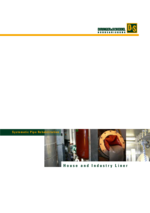The product
Over the past decades, pipe lining technology has developed into the most important method of trenchless rehabilitation of underground, pressureless drainage networks. While for a long time the main field of application of the renovation method was the common nominal widths of public sewer systems from DN 250 to DN 1000 and more, the renovation of house connections and ground pipes in small nominal width ranges is now also standard. Defective pipelines can thus be economically and permanently rehabilitated on the property, in the ground or in hard-to-reach places under the building structure. In addition to individual solutions tailored to the customer's tasks, sophisticated technology in particular contributes to optimum rehabilitation results: All components required for the installation of a hose liner are electronically controlled. In addition, a mobile impregnation system is used - a procedure that transfers the quality requirement from the public sewer network to the private house connection area.
The field of application
The field of application of house connection renovations are pipelines with small nominal diameters from DN 100 to DN 300, which are characterised by small bend radii and bends up to 90°. Accordingly, the liner used is a very flexible and flexible fabric or needle felt hose. The liner is prepared for installation at the installation site in a mobile impregnation plant equipped with a compulsory mixing unit including tempered resin and hardener tanks and roller conveyor. Its components are optimally adapted to the process: The PLC-controlled, fully automatic mixing plant operates as a closed system. The resin and hardener tanks have a volume of around 800 kg. In this way, the constant resin temperature can be maintained independent of external influences. Defined resin and hardener quantities are transported to the compulsory mixer by a controllable feed pump, brought together under exclusion of air and then fed into the vacuumed felt hose and calibrated.
The advantages
All system-relevant data is permanently documented and monitored by integrated electronic measuring devices. This offers advantages over other rehabilitation techniques, where the hose is delivered to the installation site already impregnated, or processes such as mixing resin and hardener and impregnation are carried out manually. For example, unforeseen events on the construction site can be handled in a controlled manner; furthermore, no logistical difficulties arise when transporting an unimpregnated liner. Ultimately, the quality of the liner is equal to that of the main sewer - for example, with regard to parameters such as tightness, statics or wall thicknesses to be achieved. The product has the general building authority approval of the German Institute for Building Technology (DIBt).
![[Translate to English:] Diringer & Scheidel Rohr [Translate to English:] Logo Diringer & Scheidel Rohr](/fileadmin/media/logos/DuS_Rohr_GmbH_u_Co_KG.svg)
